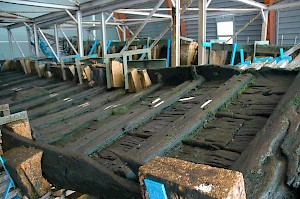Utrecht-Leidsche Rijn
Q2072212Utrecht-Leidsche Rijn: Roman fort, part of the Rhine limes, formerly known as Vleuten, and also called De Meern and Hoge Woerd.

The ancient name of the fort at Utrecht-Leidsche Rijn (also known as Vleuten) is not known.note The fort guarded a small river, the Mare, that joined the Rhine at this place. The civil settlement in the neighborhood has been excavated, with the remains of what may once have been a bathhouse. It seems that the fort offered accommodation to a naval unit (cohors I Classica pia fidelis), and was occupied from about 40 to 270.

At the moment, the city of Utrecht - itself also an ancient fort, Traiectum - is expanding to the west, where 35,000 houses are built, and archaeologists have been researching the area since 1996. To the west of the fort, they have discovered the ancient military road and watchtowers (in 2002-2003), which date back to the mid-first century and were reconstructed from stone in the second half of the second or first half of the third century. The original, wooden towers may have been part of the large building project of the Roman general Gnaeus Domitius Corbulo (47), which in turn belongs to the grand project of the Claudian army reforms.

Among the other recent discoveries are two large barges, which were sensationally well preserved. The first one, 25 meters long and made of local wood, is currently at the Dutch Institute for Maritime Archaeology in Lelystad, but there are plans to display it in a new museum. The second ship is even larger (thirty-five meters?) and has not been excavated yet. Yet it seems that it was deliberately sunk to fortify the riverbank, a not uncommon practice.
The grand total of ancient ships is, at the moment, six; the latest discovery, in 2008, was a ship that can be identified as a punt. There are also two medieval ships, which can be dated to 750 and 956.
A museum has been built on the site of the ancient Roman fort.